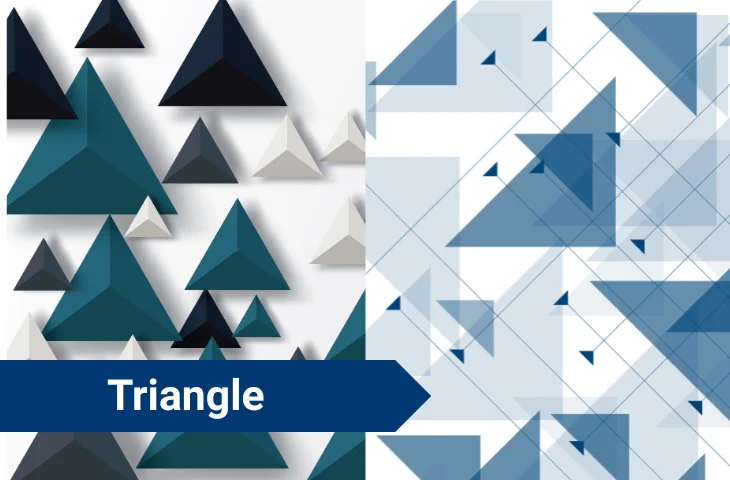Triangles are one of the most fundamental geometric shapes tested in Quantitative Aptitude exams. Questions often focus on area of triangle, perimeter of triangle, angles, and special triangle properties. In this blog, we have provided all the details about triangle definitions, formulas, shortcuts, solved questions from recent exams, and more.
What Is Triangle in Quantitative Aptitude?
A triangle is a polygon with three sides and three angles. It can be classified based on side lengths (equilateral, isosceles, scalene) or angles (acute, obtuse, right-angled).
Why it appears in exams: Triangles are used to test basic geometry, logical reasoning, and calculation speed. Many competitive exams include questions on area, perimeter, Pythagoras theorem, and ratios, making it a must-practice topic.
Skills required to solve triangle questions:
- Visualization of shapes and angles
- Logical reasoning for side/angle relationships
- Application of formulas efficiently
Why Is Triangle Important in Competitive Exams?
Triangle questions are easy to score if formulas are memorized and diagrams are drawn.
| Exam | No. of Questions | Difficulty |
| SSC CGL / CHSL | 1–2 | Easy |
| IBPS PO / SBI PO | 1–2 | Moderate |
| RRB NTPC / Group D | 1 | Easy |
| State PSC / Police | 1–2 | Moderate |
Triangle Quantitative Aptitude Short Notes
Triangles involve multiple terms and properties. The details are as follows:
| Term | Details |
| Equilateral | All three sides and angles equal |
| Isosceles | Two sides equal |
| Scalene | All sides and angles different |
| Right-angled | One 90° angle |
| Area (Heron’s Formula) | √[s(s–a)(s–b)(s–c)] |
| Perimeter | Sum of all sides |
| Pythagoras Theorem | a² + b² = c² (for right triangles) |
| Altitude | Perpendicular from a vertex to opposite side |
| Median | Line joining vertex to midpoint of opposite side |
| Angle Sum | Sum of angles = 180° |
Concepts Based on Area of Triangle
The concepts most commonly used to solve questions based on triangles are as follows:
| Concept | Details |
| Area (Equilateral) | (√3 / 4) × side² |
| Area (Right-angled) | ½ × base × height |
| Pythagoras Theorem | a² + b² = c² |
| Perimeter | Sum of all sides |
| Median Formula | √[2b² + 2c² – a²]/2 |
| Special Angles | 30°–60°–90°, 45°–45°–90° triangles |
What Are the Types of Triangle Questions in Quantitative Aptitude?
Triangle questions can appear in multiple formats:
- Direct: Simple area, perimeter, and side calculations
- Puzzle-based: Triangular number arrangements or missing values
- Coded (symbol-based): Angles or sides represented by symbols
- Mixed-concept Quantitative Aptitude: Combining triangles with algebra, ratios, or speed/distance
Triangle Formulas for Quantitative Aptitude
Formulas related to the topic of triangle are as follows:
| Formula | Details |
| Area = ½ × base × height | Standard area calculation |
| Area (Heron) = √[s(s–a)(s–b)(s–c)] | When sides are known |
| Perimeter = a + b + c | Sum of sides |
| Right triangle hypotenuse = √(a² + b²) | Pythagoras theorem |
| Equilateral area = (√3 / 4) × a² | Special triangle |
| Median = √[2b² + 2c² – a²]/2 | Line from vertex |
Triangle Tricks for SSC CGL and Other Exams
The short tricks most commonly used to solve questions based on triangles are as follows:
- Always draw the triangle to visualize sides and angles
- Use Pythagoras for right-angled triangles to save time
- Remember special triangles formulas for 30°–60°–90° and 45°–45°–90°
- Apply Heron’s formula when all sides are known
- For multiple-choice, eliminate extreme options first
- Use symmetry in isosceles and equilateral triangles
Solved Triangle Questions from 2024–25 Exams
1. SSC CGL 2024 Tier 1 – Shift 2 – Memory-Based
Question: An equilateral triangle has side 12 cm. Find its area.
Answer: 36√3 cm²
Explanation: Area = (√3/4) × 12² = 36√3
2. IBPS PO Prelims 2024
Question: Right triangle has base 6 cm, height 8 cm. Find hypotenuse.
Answer: 10 cm
Explanation: Hypotenuse = √(6² + 8²) = √(36 + 64) = √100 = 10
3. RRB NTPC 2024 – Based on Memory
Question: Area of triangle with sides 5, 12, 13.
Answer: 30 cm²
Explanation: Right triangle → Area = ½ × base × height = ½ × 5 × 12 = 30
Common Mistakes to Avoid while Solving Triangle Questions
Common mistakes to avoid while solving questions based on triangles are as follows:
- Forgetting angle sum = 180°
- Confusing area formulas for equilateral and right triangles
- Not drawing diagram miscalculating sides/angles
- Skipping units (cm² vs cm)
- Using wrong formula for median or altitude
FAQs
Draw a diagram, use formulas, and look for shortcuts like Heron’s formula.
Angles/sides represented by symbols, solved by substitution.
Sum of its three sides: a + b + c.
½ × base × height.
Sum of any two sides must be greater than the third.
- Best Books for IBPS Clerk 2026 Preparation for Prelims & Mains
- OICL AO Salary 2025, Salary Structure, and Job Profile
- OICL AO Cut Off 2025, Previous Year Prelims & Mains Marks
- SSC Stenographer Final Answer Key 2025 Out, Download Response Sheet
- OICL AO Prelims Admit Card 2026 Out, Download Call Letter
- SSC GD Total Form Fill Up 2025-26, Category Wise Details

Hi, I’m Aditi. I work as a Content Writer at Oliveboard, where I have been simplifying exam-related content for the past 4 years. I create clear and easy-to-understand guides for JAIIB, CAIIB, and UGC exams. My work includes breaking down notifications, admit cards, and exam updates, as well as preparing study plans and subject-wise strategies.
My goal is to support working professionals in managing their exam preparation alongside a full-time job and to help them achieve career growth.
